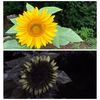Infrared Photography - Illustration of One Principle
Sep 4, 2018 15:55:56 #
I started dabbling in IR photography a few years ago, having my 1st DSLR, a Sony A-100, converted to a "color" IR camera (with a wavelength cut-off of 650 nm.) But last winter, I bought a 2nd Sony a6000 mirrorless camera (which is quite ironic for me given my early complaints posted here about the absence of built-in Image Stabilization,) directly from the dealer, who converted it per my request to Full Spectrum, which includes near UV, Visible, and near IR light. Besides being smaller in size, I found, as already asserted in the literature, that being mirrorless, it fairly accurately metered infrared light, unlike my A-100 color IR camera, in which exposure bracketing became a must. (N.B. Technically, that which most of us commonly refer to as 'Infrared Photography' is actually near Infrared Photography. This is to distinguish it from far Infrared Photography, aka Thermal Imaging.
This past Spring, I practiced using my FS camera, applying various external filters to it including those with approximate wavelength cutoffs of 590, 720, and 830 nm, as well as a 'Hot Mirror' filter (which blocks near UV and near IR light, thus reproducing the visible light-only spectrum of unconverted digital cameras,) and Lifepixel's "Super Blue", which passes through blue/purple wavelength only as well as IR light.
So what's one principle, or should I write feature, of near IR photography that those of us who take daytime, outdoor, landscape photographs might be interested in? How about seeing through haze better?
Here's a case in point, four digital photos, all taken within minutes of each other one morning this past July in Athens from my hotel. All I did was change the external optical filter for each one (and as usual, using custom WB every time a different filter was put on with an 18% gray cloth, except for the last filter, which was calibrated with a green plant in direct sunlight.)
Here's one taken with the Hot Mirror filter:
...
This past Spring, I practiced using my FS camera, applying various external filters to it including those with approximate wavelength cutoffs of 590, 720, and 830 nm, as well as a 'Hot Mirror' filter (which blocks near UV and near IR light, thus reproducing the visible light-only spectrum of unconverted digital cameras,) and Lifepixel's "Super Blue", which passes through blue/purple wavelength only as well as IR light.
So what's one principle, or should I write feature, of near IR photography that those of us who take daytime, outdoor, landscape photographs might be interested in? How about seeing through haze better?
Here's a case in point, four digital photos, all taken within minutes of each other one morning this past July in Athens from my hotel. All I did was change the external optical filter for each one (and as usual, using custom WB every time a different filter was put on with an 18% gray cloth, except for the last filter, which was calibrated with a green plant in direct sunlight.)
Here's one taken with the Hot Mirror filter:
...
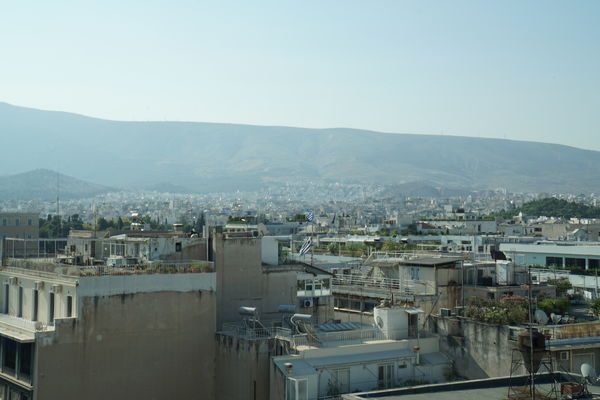
Sep 4, 2018 15:59:39 #
lev29 wrote:
Oops! This is the first time ever I'm attaching my own photos here on the Hog. I just accidentally hit the SEND softkey. I've got three more photos with narrative to attach. It'll take me just a few minutes (I hope.)I started dabbling in IR photography a few years a... (show quote)
Sep 4, 2018 16:05:09 #
lev29 wrote:
Oops! This is the first time ever I'm attaching my own photos here on the Hog. I just accidentally hit the SEND softkey. I've got three more photos with narrative to attach. It'll take me just a few minutes (I hope.)
Next is the 590 filter, which lets orange light and higher wavelengths along with IR pass.
(Gee, I don't know how to attach multiple photos, separated from each other by text. Until I learn or somehow teaches me how to do this, there will be two more such addenda to my original post.)
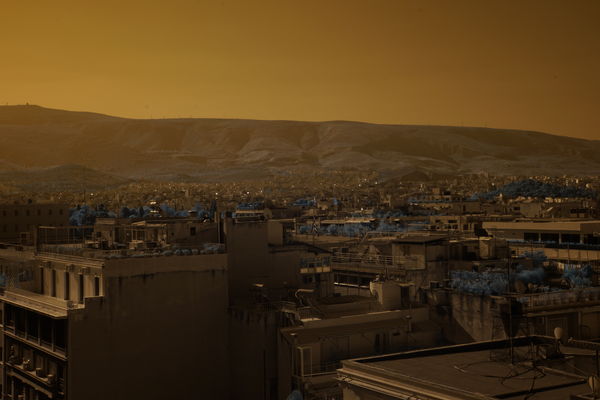
Sep 4, 2018 16:07:02 #
lev29 wrote:
Next is the Super Blue filter.Next is the 590 filter, which lets orange light and higher wavelengths along with IR pass. (Gee, I don't know how to attach multiple photos, separated from each other by text. Until I learn or somehow teaches me how to do this, there will be two more such addenda to my original post.)
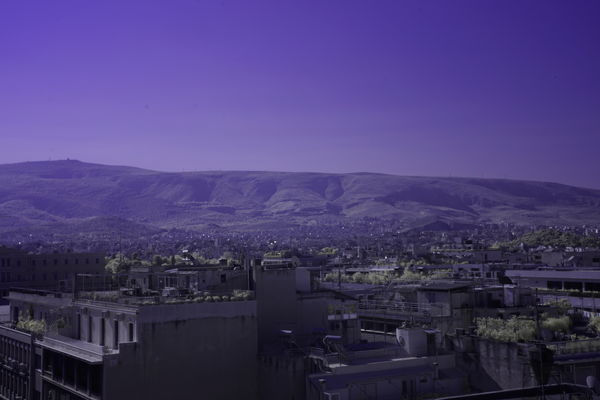
Sep 4, 2018 16:15:54 #
lev29 wrote:
Last is an infrared photo taken with a 720 nm IR filter. What it demonstrates even better than the two preceding images is how much more clearly one can visualize the contours of the distant mountains thanks to Infrared light being less scattered (when compared to visible light.) I conclude there's not much need for a Circular Polarizing filter (for the IR spectrum) given this property. The preceding was taken with the Super Blue filter.
Comments, anyone?
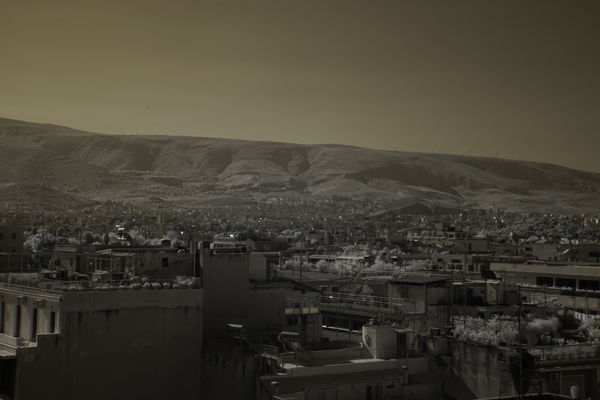
Sep 4, 2018 16:30:01 #
lev29 wrote:
I started dabbling in IR photography a few years a... (show quote)
I also have a IR converted camera. With a 667nm filter. I am rather tiring of the false-color IR and now rather wish I had a 850 nm filter put in for totally B&W IR use like the Kodak IR film I used back in the late 1970's. I supposed I could try making long exposures with the camera with via a Glass 720nm or 850nm filter over the lens. I actually own a 900nm IR filter, that is getting close to just heat. I think I have a 780nm Gel filter as well. At first I did shoot a few IR using a filter with a regular unconverted camera. Wow, long long exposures!
I'm not really fond of playing with filters these days so I would rather have a second camera set up for full time UV. But I've seen old-school color film UV with Quartz Lenses, that totally blows away the near UV (A) that transmits through glass. But what would a Quartz Nikkor cost today?!
Sep 4, 2018 22:28:38 #
lamiaceae wrote:
Wow! You're a veteran of Film IR Photography with quite a collection of filters. You say that you're tiring of the "false-color" IR photography. Well, as you probably know by now, it doesn't matter to me if I do tire of doing it one way, because with a Full Spectrum Camera, I can just buy another filter. I can even convert my color IR images to B&W, which you can do, too, with your digital color IR images. I also have a IR converted camera. With a 667nm f... (show quote)
As I wrote, I have a 1st-generation converted camera with a 650 nm filter. It was good for its time and I liked the novelty. I may give it as a gift to some young budding photographer some time. But if you don't want to blow any more bucks, just hold on to yours and get those IR-only filters. I can't answer your question (or was it rhetorical?) about that Quartz Nikkor lens. All I know is that if I want to shell out ~$200 for a UV-only filter, I should be able to obtain UV images. That's not a priority for me, though. I'm not a Dermatologist nor a Lepidopterist or a Botanist.
Thanks for your reply!

Sep 10, 2018 14:33:31 #
Help! I have been researching converting a Sony A7ii to infrared. I am very confused in choosing a IR filter spectrum, but I narrowed it down to Full Spectrum, 665nm or the popular 720nm. What is a good spectrum for landscapes & foliage. I know where to get the conversion, from Life Pixel. Yes, I read all the info. but still confused!
Sep 10, 2018 15:52:08 #
ggenova64 wrote:
I am not anti-Lifepixel, and I must acknowledge that their website offers a great deal of information, but I found one of their customer service reps to have a rather odd understanding of what "service" means. Frankly, I still would go with Kolarivision for the conversion service. I've had several most pleasant & informative Q&A e-mails with its owner and last December, they had the best deal for a brand new Sony a6000 converted (to whatever specification I wanted,) along with a good discounted price for a new Sony 18-55 mm OSS lens. The owner argued against the Sony 16-50 mm OSS lens, which he stated is well known for its IR hotspot. Help! I have been researching converting a Sony A7ii to infrared. I am very confused in choosing a IR filter spectrum, but I narrowed it down to Full Spectrum, 665nm or the popular 720nm. What is a good spectrum for landscapes & foliage. I know where to get the conversion, from Life Pixel. Yes, I read all the info. but still confused!
As for which conversion to get, now that I have experience with two forms, there's no doubt in my mind: Get the Full Spectrum conversion and be prepared to shell out $60-$80 for each filter, starting with the 'Hot Mirror' filter so that you can "reconvert it" back to taking "regular" visible light only photographs.
I'm surprised at the relative dearth of responses to this topic I started, but perhaps this is due to my initial ineptitude at posting images.
Thanks to your post, ggenova, I plan to do at least one more post of my recent IR photos, but this time I'll present them in the Photo Gallery section.
Sep 10, 2018 20:24:58 #
Kolar Vision definitely on my list! Just so I have an understanding of the spectrum. With a full spectrum conversion I can use an external IR Filter attached to the lens whatever spectrum I choose, 665nm or 720nm. Thanks for getting back.
Sep 10, 2018 20:25:45 #
Sep 10, 2018 20:53:47 #
ggenova64 wrote:
You're welcome, and it's spelled Kolarivision. Laurie Klein, a well-known professional photographer in the IR world, who authored a good book on the subject two years ago, and uses them, too. What is this AR Coating?
AR stands for Anti-Reflective coating that can be applied to the external optical filters. It makes sense to me to pay the extra $25 option for them. A few months ago, I think, Lifepixel alleged that the AR coating on Kolari filters either didn't work or was subpar. My opinion: I don’t care. I’m sticking with Kolarivision. But I did buy two Lifepixel filters, their own "Superblue" and the one with the b.s. name of "Deep Infrared," which has a cutoff around 830 nm.

Sep 10, 2018 21:37:51 #
lamiaceae wrote:
...........
I've seen old-school color film UV with Quartz Lenses,
that totally blows away the near UV (A) that transmits
through glass.
But what would a Quartz Nikkor cost today?!
I've seen old-school color film UV with Quartz Lenses,
that totally blows away the near UV (A) that transmits
through glass.
But what would a Quartz Nikkor cost today?!
More than a pinhole, thaz 4sure [hint-hint].
`
Sep 11, 2018 09:42:57 #
I have a Sony A6000 IR converted camera with the 16-50mm lens. Many of my images suffer from hotspots with this lens. Are you happy with the Sony 18-55 mm OSS lens? Is it really less prone to hotspots?
lev29 wrote:
I am not anti-Lifepixel, and I must acknowledge th... (show quote)
Sep 11, 2018 10:28:08 #
Vock Canyon wrote:
I've been using my Sony 18-55 mm OSS lens almost exclusively on my FS-converted Sony a6000 camera, and while I have yet to do any post-processing of my images (I started last May to shoot in both RAW & JPEG, by the way,) I have yet to note any hot spot artifacts in my images. I have a Sony A6000 IR converted camera with the 16-50mm lens. Many of my images suffer from hotspots with this lens. Are you happy with the Sony 18-55 mm OSS lens? Is it really less prone to hotspots?
Although your story is anecdotal, it sounds like the owner of Kolarivision is on to something. Here is his website's Lens Hotspot Database:
http://kolarivision.com/articles/lens-hotspot-list/
and one from Lifepixel: https://www.lifepixel.com/lens-considerations
With respect to my having mentioned a possible issue with respect to the AR coating on external optical filters, here is the URL to Lifepixel's allegation (which does not mention Kolarivision by name): https://www.lifepixel.com/photography-news/truth-ar-coated-infrared-filters
If you want to reply, then register here. Registration is free and your account is created instantly, so you can post right away.
